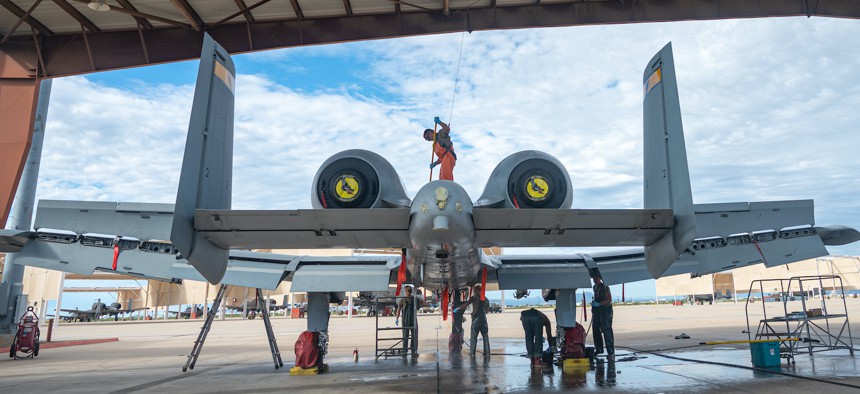
The A-10C Thunderbolt II Demonstration Team washes an A-10 Thunderbolt II at Davis-Monthan Air Force Base, Arizona, Oct. 6, 2022. U.S. Air Force / Staff Sgt. Jacob T. Stephens
The A-10 and F-35 competed in close air support tests years ago. The report just surfaced.
One prominent HASC member said he sticks behind the F-35.
A newly emerged report offers a few new details on a test that compared the A-10 Thunderbolt II attack plane and the F-35 strike fighter, but raises more questions about the 5th-generation jet’s ability to fill the A-10’s close-air support mission.
The classified report, completed in February 2022 by the Defense Department’s Office of Test and Evaluation, was recently released with heavy redactions to the Project On Government Oversight, which sued the Pentagon in federal court after its FOIA request for the report was denied.
The report describes the results of a close-air-support flyoff between the F-35A and the A-10C, which was mandated by Congress in the 2017 National Defense Authorization Act and carried out in 2019.
The test was conducted in “low- and medium-threat environments” and not in a hostile or high-threat environment because the “F-35A, along with the F-35B and F-35C, is being thoroughly evaluated during F-35 IOT&E in high threat scenarios versus modern, dense [surface-to-air missile] and fighter aircraft, missions for which the A-10C was not designed,” the report said.
No ground troops participated in the flyoff, which doesn’t “invalidate the conclusions of this report,” DOT&E wrote in the report. “However, a more dynamic and representative environment for operational testing of these missions may be needed to judge improvements in performance in these or any other systems under test.”
Many details are blacked out in the version released to POGO. For example, it says the A-10 “enabled more attacks than the typical loadout of the F-35A” but does not reveal how many targets each aircraft hit in the test.
The redactions make it hard to discern the context of some of the statements. But there are hints that it required more F-35 sorties than A-10 sorties to accomplish some missions. For example, this half sentence (“sorties than A-10C sorties would be necessary to attack the same number of targets”) is followed by this text: “The number of sorties necessary to complete the same mission objectives in contested environments would depend on air defense suppression plans.”
That may stem in part from the A-10’s ability to carry more munitions. The attack plane was designed around a massive GAU-8 30-millimeter gun that holds 1,350 rounds of ammunition, while the F-35’s GAU-22 25-millimeter gun can only carry about 181 rounds.
Elsewhere, the report noted the A-10’s ability to fly closer to targets than the F-35:
"The test team did not record the slant range to the target with the generated coordinates, so its effect cannot be directly assessed. Even so, tactics typically caused A-10C pilots to fly closer to the target than F-35A pilots, which could explain some of the differences in the measured location errors. Target location error only affects the use of GPS-aided weapons. In any case, the location error is sufficient to cue another [close air support] aircraft's targeting pod."
The report also noted that the newer gun hasn’t always managed to shoot straight. DOT&E told the Pentagon to “fix the F-35A gun, improve digital communication, video data link capability and interoperability with 4th generation aircraft, and develop training programs to further improve F-35A effectiveness in these missions.”
Russ Goemaere, a spokesman for the F-35 Joint Program Office, told Defense One that the program has “improved” the gun and the jet’s interoperability with 4th-gen fighters and said “they are effective.”
In his own analysis, POGO’s Dan Grazier wrote, “Despite the heavy redactions in the released report, it is clear the results of these flawed tests disappointed the powers that be. Had the F-35 come out as the winner, there can be little doubt that a clear, declarative statement to that fact would have prominently appeared in the opening paragraph of the report.”
The Air Force would not comment on the report, nor say whether service leaders had tried to prevent the report’s release. A spokesperson said that close air support is a mission, not a specific platform.
“The future force will be inherently close air support-capable, with the multi-role capabilities to ensure survivability in all scenarios. While successful in permissive environments, the A-10 is not survivable in a highly-contested future fight,” said service spokesperson Ann Stefanek.
The U.S. military has made heavy use of the A-10 in recent decades, deploying it to Iraq for multiple conflicts and to Afghanistan against the Taliban. More recently, the U.S. sent Warthogs to the Middle East to deter aggression and prevent the Israel-Hamas war from spreading.
Air Force officials have long sought to retire the A-10, which was introduced in 1977 as a Soviet tank-buster. But their arguments—that the money would be better put toward more modern aircraft, that satellite-and-laser-guided bombs were sufficient for close air support missions—met fierce resistance from lawmakers whose districts were home to A-10s or the ground troops they protected. Still, recent years appear to be bringing the plane’s service to a close.
When asked about the report, one of the House Armed Services Committee’s prominent members said he’s ready to bid farewell to the A-10—if not its capabilities. Rep. Rob Wittman, chairman of HASC’s tactical air and land forces subcommittee, says he’s confident the Air Force can find a way to retain CAS capabilities as it moves to the F-35.





